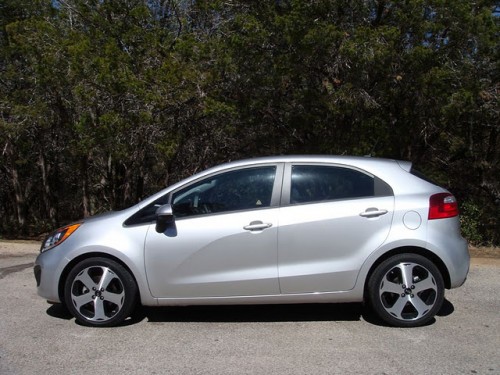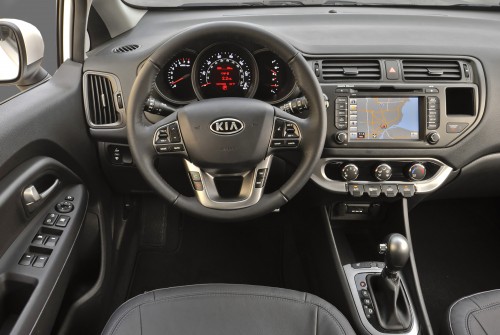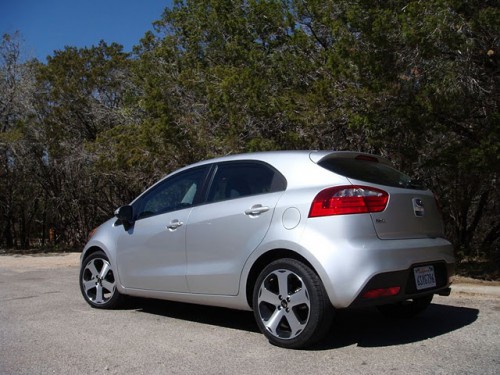2012 Kia Rio5: Another Great Small Car? Here We Go Again.
- October 24, 2011
- Kia, On The Road: Driving Impressions, Uncategorized
- Posted by Ed Kim
- Comments Off on 2012 Kia Rio5: Another Great Small Car? Here We Go Again.
This is almost becoming repetitive. How many times have we reviewed a new small entry level car and declared it filled to the brim with style, features, performance, and personality? It’s gotten to the point where I was searching hard for another angle with this all-new 2012 Kia Rio5 that I recently got to drive in Austin, Texas, but as it turns out, I’m going to have to essentially tell you the same story again.
Don’t click “Back” just yet though. You as the reader may be tired of reading about how today’s new small cars are wonderful and how there are truly no bad cars anymore, but the new Rio really does have some interesting talking points – and it’s truly a great small car. And besides, the fact that we at AutoPacific collectively find plenty to love about the latest crop of small cars means that there truly is some great machinery for budget-minded buyers – or simply people who want a full-featured and enjoyable smaller car – and that the segment has made some serious strides lately. These cars aren’t penalty boxes anymore (despite the $13,500 starting price of the new Rio). Simply, they are “real” cars with real features, only a bit smaller than many are used to.
The 2012 Rio5 is all-new and shares most of its greasy bits under the skin with the also-new-for-2012 Hyundai Accent. As related as they are under the skin, it is shocking just how different their personalities are. The Accent is pleasant and cosseting, and styled to look contemporary in an “Asian” sort of way. As distinctive as its styling is, the Accent could easily have come from Japan, not Korea.
The Rio5, which as you might guess from the name is a five-door hatchback (a sedan arrives at the beginning of 2012), is a different story. Its overall execution both inside and out screams “German”, from its taut and chiseled – but also simple – forms and sculpting. This shouldn’t be surprising as several years ago, Kia hired away Peter Schreyer, one of Audi’s then-top designers, to run Kia’s design studios.
To my eyes, this may be the pick of the entry level subcompact bunch in terms of looks. It looks sporty without looking like it’s trying too hard, much as a small German hatchback would. There is neat detailing all over the car, inside and out, and the entire package leaves a strong impression of product quality. Kia clearly paid plenty of attention to the finer aesthetic details.
There’s plenty of innovation under the skin. Under the hood lies a new aluminum-block 1.6L DOHC 16v inline-four with direct injection. It makes a very healthy 138HP – up a whopping 28HP over last year’s model. It can be paired to a six-speed manual in the cheapest base mode, but the vast majority will come with a slick six-speed automatic. With either transmission, the Rio is rated by the EPA to consume 30 MPG in the city and 40 MPG on the highway – much more efficient than its far less powerful predecessor. Impressive, indeed.
Also of note is the availability of Kia’s new ISG (Integrated Stop Go) system. This slick feature shuts the engine off when the vehicle is at a standstill, such as at a stoplight. The engine seamlessly and automatically turns back on when the driver releases the brake pedal. With ISG, city fuel economy is rated at +1 MPG (31 MPG), but Kias staff insist it can actually provide a much greater benefit than that out in the real world.
There is great technology inside the stylish cabin as well. Kia’s UVO by Microsoft infotainment interface is available and is conceptually similar to Ford’s SYNC – also engineered by Microsoft. It can operate your personal electrical devices via your own voice and in our tests, works pretty well. Sadly, UVO is not offered in conjunction with Kia’s very good navigation system, also an option, at this time. So for the time being, the driver must choose between UVO and navigation.
Out on the road, the Rio5 mostly acquits itself nicely, save for one major flaw that I’ll get back to shortly. The engine is powerful and sweet, the transmission does its job precisely, and the cabin remains quiet at all speeds (even more so, seemingly, than the related Accent, which I drove just a couple weeks before drivin the Rio5). And on the sporty SX model that I drove, the suspension felt nice and tight while providing a class-competitive ride.
I’ll tell you what the problem (or what I think the problem) is. It’s the low rolling resistance tires. At speed, the car wanders slightly. On curvy, twisty roads, the tires not only lose grip easily, but the car’s handling feels somewhat mushy and imprecise. And during one emergency stop I had to abruptly make, the car weaved left and right a bit as it decelerated. For the purpose of achieving maximum fuel economy, Kia has chosen to equip all Rio models with low rolling resistance tires. Even the seventeen-inch versions on my sporty SX model lent the car a less agile and enthusiastic drive character this car deserves. The great styling alone makes promises that can’t be delivered – at least not with these tires.
But that’s about it for my criticisms. Drive your new Rio5 to the nearest tire store and the issue may very well be solved. And aside from those issues, it’s an exemplary small car. It’s roomy both front and rear, it’s great to look at, it seems to ooze quality.
So once again, we’re forced to bestow praise on another great new small car. But really now, how can that possibly be a bad thing?





